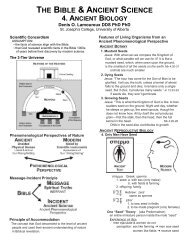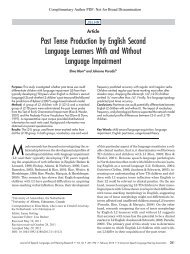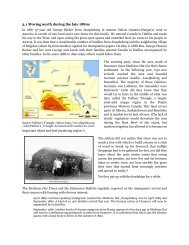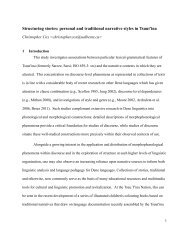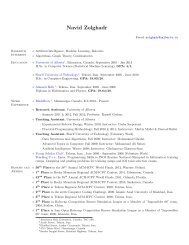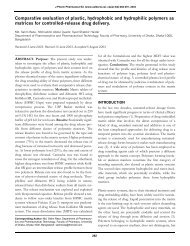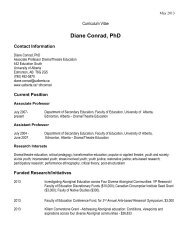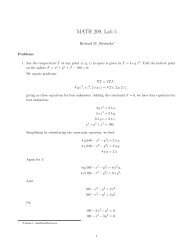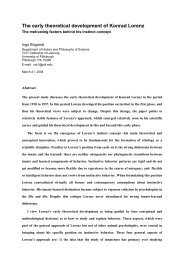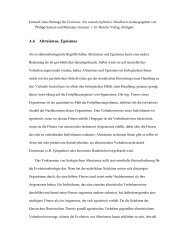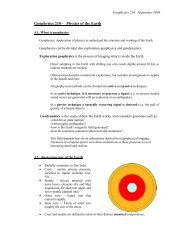Forum Deutsch - University of Alberta
Forum Deutsch - University of Alberta
Forum Deutsch - University of Alberta
Sie wollen auch ein ePaper? Erhöhen Sie die Reichweite Ihrer Titel.
YUMPU macht aus Druck-PDFs automatisch weboptimierte ePaper, die Google liebt.
HERBST 2005 37 <strong>Forum</strong> <strong>Deutsch</strong><br />
and the external input, the interviewee saw the shape <strong>of</strong> the person<br />
in his mind’s eye. The shape was usually <strong>of</strong> the person’s face<br />
and shoulders. At this point, the subject looked for a key movement<br />
in his mental visual images that he considered typical for<br />
the person in question. These images were clear enough for identification<br />
but not clear enough for details. The more he liked the<br />
person, the more the mental visual images <strong>of</strong> that person were in<br />
color. These mental images <strong>of</strong> the person in question are located<br />
near and in front <strong>of</strong> the interviewee.<br />
Shortly after the test person commenced viewing his mental<br />
visual images, his inner voice considered how the to-be-mimicked<br />
person sounded to the test person. The voice, the accent, the<br />
color <strong>of</strong> voice, and temperature <strong>of</strong> voice <strong>of</strong> the to-be-mimicked<br />
person were important. The subject also focused on whether the<br />
voice <strong>of</strong> the to-be-mimicked person “transported” any kind <strong>of</strong><br />
emotion that could be important for the successful mimicking <strong>of</strong><br />
that person.<br />
While accessing these two types <strong>of</strong> mental images, the test<br />
person emotionally stimulated his body according to what he saw<br />
and heard in order to copy this person. After which he tested<br />
externally his conclusions by acting like this person. At this<br />
point, he felt as if he were putting on a coat <strong>of</strong> his feeling <strong>of</strong> this<br />
person.<br />
In this strategy, we see that the test person had to have<br />
external input and access the appropriate (positive) feeling for<br />
this situation. He started viewing his images in his inner eye and<br />
listening to his images in his inner ear that provided him with the<br />
necessary internal feelings and internal visual and auditory<br />
images to mimic his person. Finally, he mimicked this person<br />
externally to get feedback from others. If the others laughed and<br />
enjoyed or even praised his good work, he was satisfied and<br />
accepted what he had learned.<br />
A negative learning strategy is for learning business associates’<br />
names. This strategy normally transpired at meetings where<br />
the interviewee met new business associates. At this time the<br />
subject was rather excited and/or nervous because <strong>of</strong> the situation.<br />
The external input was either visual through reading the<br />
name on a business card or auditory through an oral introduction.<br />
The interviewee saw the whole person, whose name he<br />
wanted to learn in his mind’s eye. This internal picture consisted<br />
<strong>of</strong> the person and the last situation both concerned parties were<br />
in. This mental visual image was in color but without details and<br />
was relatively clear. Nowhere in the strategy did the subject have<br />
any internal sounds associated with the strategy.<br />
The interviewee searched his mental picture for the needed<br />
name; however, he could not find it in the mental visual image.<br />
Consequently, he tried to use as many other visual connections as<br />
possible; at the same time he gets more and more frustrated.<br />
Finally, he jumped from one mental picture to another unsuccessfully<br />
trying to find the connection that would give him the name.<br />
This procedure led to the subject being blocked and just stopping<br />
the process.<br />
Memory Storage<br />
The manner <strong>of</strong> storing information can affect its successful<br />
retrieval. Grinder (1989) believes that the visual mode is the<br />
most effective means for storing information. The visual mode <strong>of</strong><br />
storage works almost like a movie. When looking for stored information,<br />
one simply has to fast-forward, or rewind the movie.<br />
One can watch for the needed information, stop the film any<br />
time, and retrieve the needed material.<br />
However, Service (1992) has found that the auditory mode<br />
<strong>of</strong> storing information is essential for successfully acquiring foreign<br />
language vocabulary. She has found that the improper use <strong>of</strong><br />
the auditory mode can impair or impede the learning <strong>of</strong> vocabulary.<br />
Auditory storage can function very much like a cassette<br />
recorder. You must fast-forward it or rewind it and again and<br />
again stop the cassette to hear if you have found the right location.<br />
Auditory storage is not as an effective process as the visual<br />
mode. It does, however, have its advantages, for example, when<br />
it is not possible for the person to visualize, when the input and<br />
output channels are both auditory, i.e. music, and when information<br />
is sequenced (Grinder, 1989).<br />
Syer and Connolly (1987) maintain that the kinesthetic<br />
mode is pertinent in storing information, for example, when<br />
learning a sport. Logie (1995), however, maintains that many<br />
forms <strong>of</strong> movement are stored visually. Kinesthetic storage resembles<br />
a roller coaster ride. The kinesthetic information is stored,<br />
for example, in vibrations. As you roll along the rollercoaster<br />
track, you feel all the vibrations, but you are unable to put your<br />
finger on the vibration you are looking for. On this ride it is also<br />
rather difficult to stop just anywhere. Perhaps this is the reason<br />
why various forms <strong>of</strong> motion are visually stored. However, this<br />
mode <strong>of</strong> storage is essential for emotions that play an important<br />
role in learning (Goleman, 1995).<br />
Rudolf Arnheim (1969) asserts that all thinking - no matter<br />
how theoretical - is visual in nature. Even though the visual mode<br />
is the most widely used mode for learning and storing information,<br />
we need to teach students how to use all sensory forms <strong>of</strong><br />
learning and storage to be effective and flexible learners. The<br />
visual mode is in general the most effective mode for the learning<br />
and storing <strong>of</strong> information but not the only one.<br />
Language Learning Strategies<br />
Scarcella and Oxford (1992) define a learning strategy for<br />
foreign languages as “specific actions, behaviors, steps, or techniques<br />
– such as seeking out conversation partners or giving oneself<br />
encouragement to tackle a difficult language task – used by<br />
students to enhance their own learning” (p. 63). A strategy indicates<br />
conscious movement toward a goal, and Pressley and<br />
McCormick (1995) believe that language learning strategies need<br />
to be controllable so learners can take measures to manage their<br />
learning and reach desired goals. According to Cohen (1998), a<br />
strategy is habitual when the user is no longer consciously aware<br />
<strong>of</strong> it and then Cohen (1998) considers it a process and not a strategy.<br />
Strategies for L2 need to facilitate the learners’ autonomy<br />
and at the same time support the learner’s conscious control <strong>of</strong>



